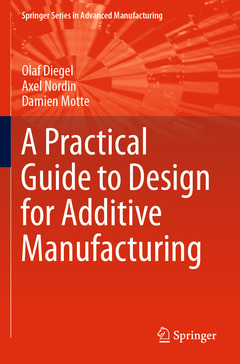A Practical Guide to Design for Additive Manufacturing, 1st ed. 2019 Springer Series in Advanced Manufacturing Series

This book provides a wealth of practical guidance on how to design parts to gain the maximum benefit from what additive manufacturing (AM) can offer. It begins by describing the main AM technologies and their respective advantages and disadvantages. It then examines strategic considerations in the context of designing for additive manufacturing (DfAM), such as designing to avoid anisotropy, designing to minimize print time, and post-processing, before discussing the economics of AM.
The following chapters dive deeper into computational tools for design analysis and the optimization of AM parts, part consolidation, and tooling applications. They are followed by an in-depth chapter on designing for polymer AM and applicable design guidelines, and a chapter on designing for metal AM and its corresponding design guidelines. These chapters also address health and safety, certification and quality aspects. A dedicated chapter covers the multiple post-processing methods for AM, offering the reader practical guidance on how to get their parts from the AM machine into a shape that is ready to use. The book?s final chapter outlines future applications of AM.The main benefit of the book is its highly practical approach: it provides directly applicable, ?hands-on? information and insights to help readers adopt AM in their industry
Includes numerous practical examples on how to design components to be suitable for additive manufacturing
Provides in-depth coverage not only of the printing processes themselves, but also of the many post-processing techniques that must be used in additive manufacturing
Helps readers understand the design factors that can affect the economic viability of additive manufacturing
Date de parution : 08-2020
Ouvrage de 226 p.
15.5x23.5 cm
Date de parution : 05-2019
Ouvrage de 226 p.
15.5x23.5 cm
Mots-clés :
Design for Additive Manufacturing (DfAM); Light-Weighting; Topology Optimisation; Additive Manufacturing Economics; Polymer Additive Manufacturing; Metal Additive Manufacturing; Additive Manufacturing Post-Processing; Rapid Prototyping; Layer-Based Fabrication; Layer-Based Manufacturing; AM Computational Design
Ces ouvrages sont susceptibles de vous intéresser

Metal Additive Manufacturing 124,14 €


